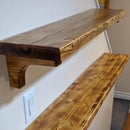Introduction: Cedar Planking Clock
Another day, another project. This time it's a bit of a deviation from the usual pallet wood stock, and instead we get to play around with some gorgeous cedar tongue and groove planking.
During a friend's basement renovation project, one of the small rooms getting demolished had beautiful cedar tongue and groove planking lining the walls and door (which was the style a few decades ago), and instead of throwing it all away what better use was there for it than giving it a new life as a piece of functional art?
Supplies
Power tools such as a table saw, router, belt and palm sanders.
Clock mechanism: https://www.amazon.ca/gp/product/B07W7X8LZZ/ref=p...
Table saw cross cut sled based on Fisher's Shop's design:
Table saw circle cutting jig based on Fisher's Shop's design:
Step 1: Gathering and Preparing the Cedar
Once the basement demolition was underway, we managed to save all the longer pieces of cedar that were still in good shape. Some came off in long strips and some were just cut off the wall in large sections. Once it was all collected, the first thing to do was separate the individual planks, remove and recycle all the nails, and throw out any pieces that were damaged or just too small.
The next step was to glue the planks into sets of three, since each one was about 3/8" (9.5mm) thick which was too thin to work with. When grouping them, the ones with the nicer grain patterns were kept for the outside while any with small cracks or plain colors went inside. The bundles were also grouped by length so as to maximize the yield of the glue-ups.
Step 2: Cutting Material Down to Size
With all the planks now glued into sets of three, the first thing to do was joint one side of each bundle - essentially giving it a clean straight edge. In larger shops you'd have access to a jointer that would quickly do this, but it's quite possible to do with a table saw and jointer sled. Simply attach the bundle to the sled, let the rough side hang off the edge, and pass it through the blade.
When you've jointed all the bundles, you can then start cutting 1" (2.54cm) wide strips by setting the table saw's fence to that width and the passing the bundles through it as many times as they will yield material. In our case, they were all about 2.5" (6.35cm) wide so they yielded two strips each.
And finally, using a cross cut sled, start cutting the individual pieces needed for the pattern of choice. This clock was made using a hearing bone pattern with a 3-1 ratio), so three scrap pieces of the 1" strips were lined up against the cut line, a stop block was set in place next to them, and then all the strips were cut to that length.
Step 3: Pattern Assembly and Glue-up
Here's where the fun begins, as you begin to see the final pattern take shape. The clock mechanism used here has a minute hand that is approximately 7" (17.8cm) long, so by placing the hour markers an inch away from the tip and then giving the clock an extra 1" (2.54cm) of margin that, we ended up with a radius of 9" (22.86cm).
Since dealing with square shapes is much easier than circles (as far as glue-ups are concerned), this would result in a square that was 18" x 18" (45.7 x 45.7cm) for the finished size, so an extra inch was added on top of that to allow for final losses due to cutting and sanding. The final size of the square was therefore 19" x 19" (48.26 x 48.26cm).
For this design we also took the extra step of removing five blocks from random spots in order to make it a bit more unusual, and figuring out the best place for those missing pieces was done by just laying down a template and playing around with a couple of options.
Once the right one was selected, the removed pieces were wrapped in tape and their location was marked on the glue-up mold so the pattern could be easily replicated, and the glue-up process began. All pieces were removed from the mold, and then one by one had glue applied and were repositioned. Once everything was back in place, clamping pressure was applied by using pairs of wedges that were all pushing against a flat surface wrapped in tape.
Finally, while showcasing each piece's face was a great option and would have highlighted the grain and color patterns on it, we chose to leave the pieces on their sides and show the lamination instead. It provides a different kind of look, similar to what many plywood projects look like when they showcase the equivalent of their edge grain.
Step 4: Shaping and Sanding
The next step is to cut the circle out of the glue-up and start shaping it. The circle can be cut out using a variety of mechanism and templates, but in this case we went with a simple table saw circle cutting jig that easily lets the user cut large circles.
The jig's principle is simple: the piece has a small hole drilled in its center, and is then put upside down over the jig, which has a nail protruding at a fixed distance from the blade. That distance is basically the desired circle's radius, and the jig lets you set the desired radius before fixing it in place.
When ready, the jig is simply slid into the blade over and over, with the piece gets rotated slightly in between cuts. After a dozen cuts or so, the outer edge of the piece becomes circular enough for you to be able to leave the jig right up by the blade and simply rotate the piece in place, which smooths the edges down. A touch of sanding then leaves you with a perfect circle.
After the circle has been cut out, the five taped pieces were removed by simply tapping on them with a bit of scrap wood and a hammer. The tape ensures they would not get glued in, and their removal was very easy.
Sanding is the second to last step, and this just went through a belt sander with an 80 grit belt followed by a orbital sander with 80 and 120 grit discs. A small detail sander was also used to smooth out the inside of the five holes.
One extremely handy thing to keep track of is the fine sawdust created by the sanding. It's always a good idea to collect and store it, since this will be the perfect material to use when filling in small holes or cracks in the glue-up. If you have them, simply mix the dust with some regular white glue, add a couple of drops of water to soften it, and apply with a spatula. Let it dry, come back and sand with 120grit sandpaper, and voila.
As a last touch, a router with a 1/4" round-over bit was used to clean the edges and give them a comfortable rounded feel.
Step 5: Making It Look Like a Clock
Now that the face is done, it's time to start make it look like a clock.
On the back side, a hollow was dug out with a router and straight bit (although spiral down cut bit would probably be most appropriate here) to accommodate the clock's motor, and a center hole was drilled out so the shaft could stick out through to the other side.
For the hour markers, the face was divided into four gradients marking the 3, 6, 9 and 12 positions, and then a measuring tape was used along the outside of the face to divide each quadrant into three in order to get the rest of the hourly positions. Each of the resulting lines then had a mark made 1" (2.5cm) away from the face, and a bowl bit was used to drill a small recess in each position.
When all 12 markers were complete, the entire face (with exception of the markers) was covered in painter's tape and sprayed black. Once a couple of coats had been applied and were dry, the tape was removed and a final sanding was done to remove any little bits of paint that might have seeped through the tape.
Step 6: Finishing Details
The finish applied to a piece can be one of many choices, and you also have the opportunity to further stain the wood, char or blacken it, etc before applying a protective finish. In our case, we simply went with Danish oil, which is an oil/varnish combination that brings out the different colours and grain patterns in a most beautiful way and also provides lasting protection.
When the coatings had all dried, the clock's mechanism was finally installed, the time set, and the whole piece was hung up for display.
We hope you enjoyed this article. Please feel free to share your thoughts and ideas ab

Runner Up in the
Reclaimed Materials Contest













